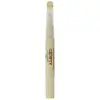What's inside
What's inside
 Key Ingredients
Key Ingredients

 Benefits
Benefits

 Concerns
Concerns

 Ingredients Side-by-side
Ingredients Side-by-side

Thujopsis Dolabrata Branch Extract
Skin ConditioningCarthamus Tinctorius Seed Oil
MaskingOryza Sativa Bran Oil
EmollientGlycerin
HumectantStearic Acid
CleansingCetyl Alcohol
EmollientTheobroma Cacao Seed Butter
EmollientButyrospermum Parkii Butter
Skin ConditioningTocopheryl Acetate
AntioxidantPhenoxyethanol
PreservativeAloe Barbadensis Leaf
MaskingSodium Stearate
CleansingGlyceryl Stearate
EmollientXanthan Gum
EmulsifyingUndaria Pinnatifida Extract
Skin ConditioningHydrolyzed Lycium Barbarum Fruit
Skin ConditioningRetinyl Palmitate
Skin ConditioningEthylhexylglycerin
Skin ConditioningLavandula Angustifolia Oil
MaskingThujopsis Dolabrata Branch Extract, Carthamus Tinctorius Seed Oil, Oryza Sativa Bran Oil, Glycerin, Stearic Acid, Cetyl Alcohol, Theobroma Cacao Seed Butter, Butyrospermum Parkii Butter, Tocopheryl Acetate, Phenoxyethanol, Aloe Barbadensis Leaf, Sodium Stearate, Glyceryl Stearate, Xanthan Gum, Undaria Pinnatifida Extract, Hydrolyzed Lycium Barbarum Fruit, Retinyl Palmitate, Ethylhexylglycerin, Lavandula Angustifolia Oil
Prunus Amygdalus Dulcis Oil
Skin ConditioningLanolin
EmollientOlea Europaea Fruit Oil
MaskingGlycine Soja Oil
EmollientTriticum Vulgare Germ Oil
EmollientVitis Vinifera Seed Oil
EmollientC10-30 Cholesterol/Lanosterol Esters
EmulsifyingCera Alba
EmollientSilica Silylate
EmollientCocoyl Hydrolyzed Oat Protein
CleansingTocopherol
AntioxidantParfum
MaskingHydrolyzed Vegetable Protein
Skin ConditioningCarthamus Tinctorius Seed Oil
MaskingWater
Skin ConditioningPanthenol
Skin ConditioningHexyl Cinnamal
PerfumingEquisetum Hyemale Extract
Skin ConditioningRetinyl Palmitate
Skin ConditioningTetrahexyldecyl Ascorbate
Antioxidant3-Hydroxybenzoic Acid
Skin ConditioningLinalool
PerfumingHydroxycitronellal
PerfumingLimonene
PerfumingCoumarin
PerfumingCitric Acid
BufferingPrunus Amygdalus Dulcis Oil, Lanolin, Olea Europaea Fruit Oil, Glycine Soja Oil, Triticum Vulgare Germ Oil, Vitis Vinifera Seed Oil, C10-30 Cholesterol/Lanosterol Esters, Cera Alba, Silica Silylate, Cocoyl Hydrolyzed Oat Protein, Tocopherol, Parfum, Hydrolyzed Vegetable Protein, Carthamus Tinctorius Seed Oil, Water, Panthenol, Hexyl Cinnamal, Equisetum Hyemale Extract, Retinyl Palmitate, Tetrahexyldecyl Ascorbate, 3-Hydroxybenzoic Acid, Linalool, Hydroxycitronellal, Limonene, Coumarin, Citric Acid
Alternatives
Ingredients Explained
These ingredients are found in both products.
Ingredients higher up in an ingredient list are typically present in a larger amount.
Carthamus tinctorius seed oil comes from safflower, one of humanity's oldest crops.
Safflower seed oil contains a high percentage of linoleic acid and oleic acid. It also contains Vitamin E. These three components are effective moisturizers.
Vitamin E helps nourish your skin's lipid barrier. It is also a potent antioxidant. Antioxidants help fight free-radical molecules, or unstable molecules that may damage your skin cells.
Due to its high fatty acid content, this ingredient may not be malassezia folliculitis safe.
Thoughout history, safflower has been used for dying fabrics and in food as a saffron substitute.
Learn more about Carthamus Tinctorius Seed OilRetinyl palmitate is a form of retinoid. Retinoids are the superstar class of anti-aging ingredients that include tretinoin and retinol.
This particular ingredient has had a bumpy year with its rise and fall in popularity.
First, Retinyl palmitate is created from palmitic acid and retinol. It is a retinol ester and considered one of the weaker forms of retinoid.
This is because all retinoids have to be converted to Tretinoin, AKA retinoic acid. Retinyl Palmitate is pretty far down the line and has to go through multiple conversions before its effects are seen.
Due to this long and ineffective conversion line, the benefits of Retinyl Palmitate are debated.
Studies show Retinyl Palmitate to help:
Dermatologists say this ingredient is ineffective because it isn't used in high enough concentrations in cosmetics.
This ingredient used to be found in sunscreens to boost the efficacy of sunscreen filters.
The downfall of Retinyl Palmitate was due to released reports about the ingredient being correlated to sun damage and skin tumors.
While there is a study showing this ingredient to cause DNA damage when exposed to UV-A, there is no concrete proof of it being linked to skin cancer. It is safe to use when used correctly.
All retinoids increase your skin's sensitivity to the sun in the first few months of usage. Be especially careful with reapplying sunscreen when using any form of retinoid.
Currently, this ingredient is still allowed in cosmetics all over the world. In Canada, cosmetics must have a warning label stating the product to contain Retinyl Palmitate
Fun fact: This ingredient is often added to low-fat milk to increase the levels of Vitamin A.
Learn more about Retinyl Palmitate